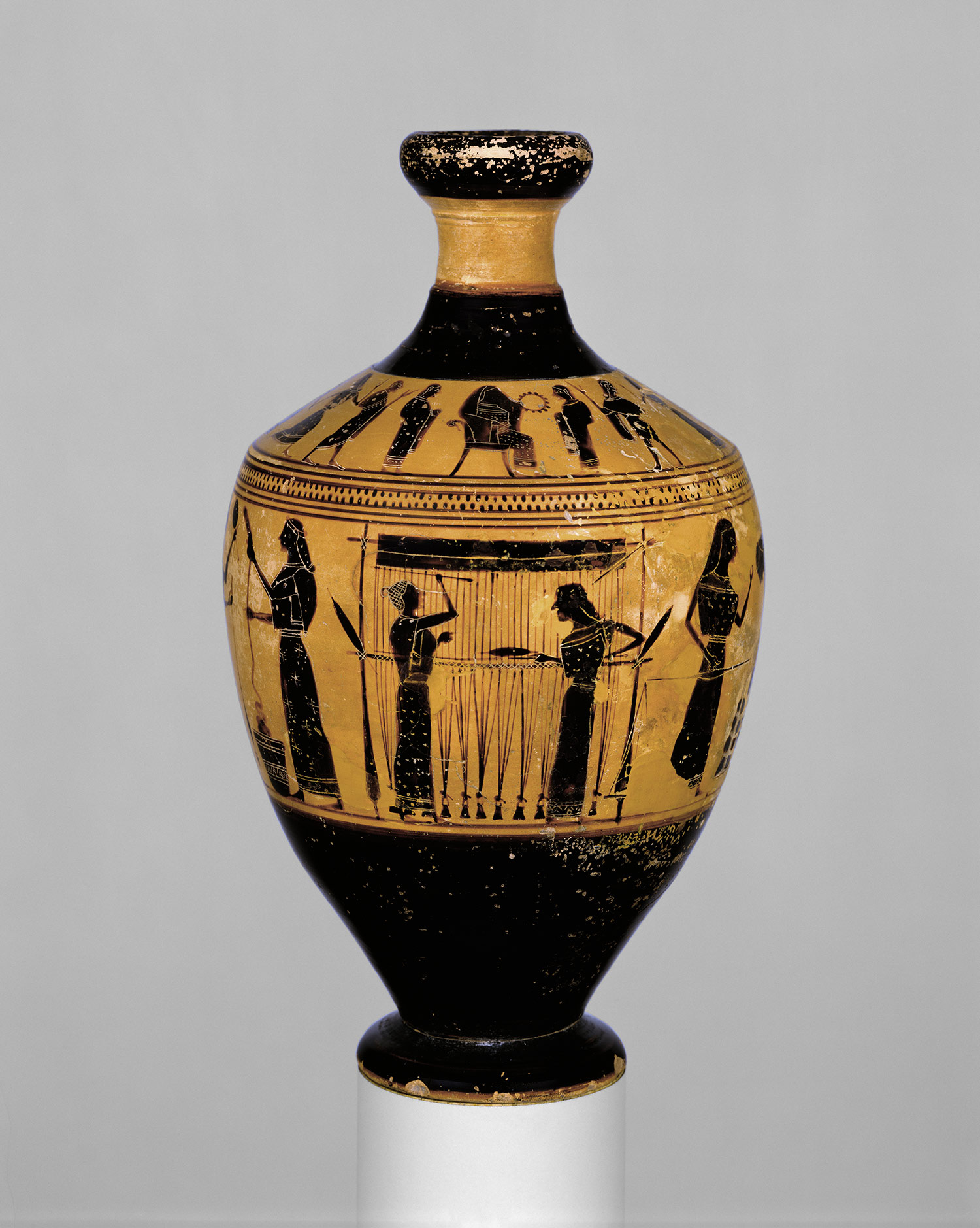Textile is a material that deteriorates easily over time. For this, ancient textile artifacts are rather rare. Fortunately, many evidences about ancient textile arts can be found in other, more long-lasting forms of art, like pottery and painting. For example, information about pre-historic textiles can be found in several ceramic impressions. Another source of information is pottery painting.
One of the most interesting examples of pottery painting is a black-figure lekythos (530-550 B.C), made for oil storing and attributed to the Amasis painter. The painter has depicted around the vessel, female figures engaging in various stages of wool working.
 |
| Lekythos, 530-550 B.C, Archaic, black-figure Attributed to the Amasis painted Image copyrights and source: The metropolitan museum of Arts |
At the center of the vessel, two women weave in the typical ancient Greek loom, the upright loom with weights. In this type of loom, the warp threads were attatched to an upper, horizontal beam. To keep these threads taut, several weights, like stones, were tied to the ends of the warp threads. The weavers were working from top to bottom, while the finished portion was gradually rolled up around the top beam.
This type of loom was pretty long and demanded the contribution of two weavers. As we see in the illustration, the left weaver, pushes the weft threads with a stick while the right weaver separates the warp threads with a rod. To the right of the room, two women remove the wool from a basket while a third supervises the operation. The next scene, depicts two women folding carefully a finished cloth. In front of them, there is a low stool with a folded cloth on it. The next female figure spins wool into yarn and the last figure, works with the unspun wool.
This type of loom was pretty long and demanded the contribution of two weavers. As we see in the illustration, the left weaver, pushes the weft threads with a stick while the right weaver separates the warp threads with a rod. To the right of the room, two women remove the wool from a basket while a third supervises the operation. The next scene, depicts two women folding carefully a finished cloth. In front of them, there is a low stool with a folded cloth on it. The next female figure spins wool into yarn and the last figure, works with the unspun wool.
 |
| Lekythos, 530-550 B.C, Archaic, black-figure Attributed to the Amasis painted Image copyrights and source: The metropolitan museum of Arts |
The lekythos, links weaving with marriage. Just above the loom, there is a seated woman holding and offering her veil in a gesture associated with brides in ancient Greece. So, those vessels are an important source of information, not only because they provide evidence about textile arts and techniques but also because they depict daily social scenes, allowing the researchers to learn more about ancient societies, customs and beliefs. In ancient Greece, weaving was an important occupation for women while a competent weaver was considered a good wife. This particular perception, the correlation of textile arts with the value of a woman, can be found in many cultures (Kuna Indians and Mola Art) and also in modern Greece until recently (note 1).
Note 1:
- My mother in law, who lives in Greece, when she was young (about 1960) was considered an attractive wife and had many marriage proposals, exaclty because she was a skillful weaver.
References:
- Metropolitan museum of art. Lekythos, ca. 550–530 B.C.; Archaic, black–figure. [ONLINE] Available at: http://www.metmuseum.org/toah/works-of-art/31.11.10. [Accessed 23 January 15].
- Ι. Τζαχίλη, '. 1997. Ο αρχαίος αργαλειός (κάθετος αργαλειός με βάρη). [ONLINE] Available at:http://www.panoreon.gr/files/items/3/363/o_arhaios_argaleios.pdf. [Accessed 23 January 15].
- Mary Schoeser, 2003. World Textiles: A Concise History (World of Art). Edition. Thames & Hudson.

No comments:
Post a Comment